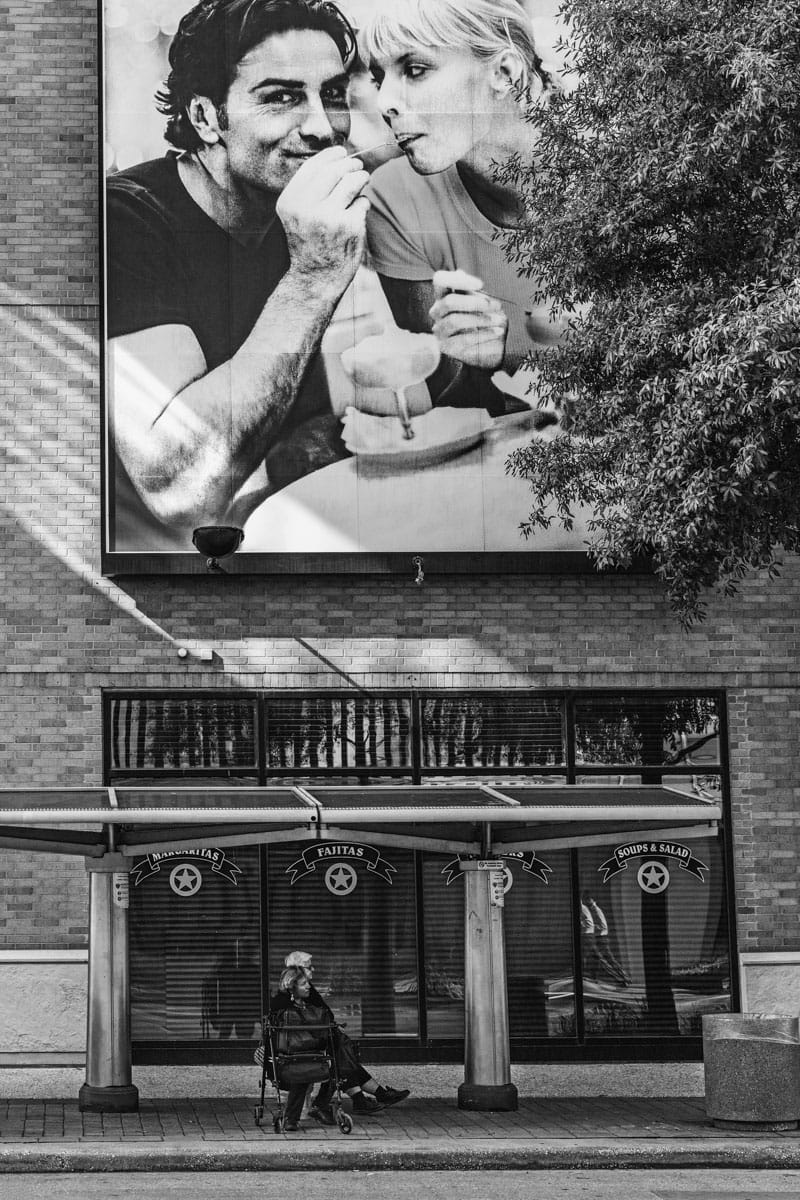Street Photography
Street photography is one of the more exciting genres in photography. It forces us to get out of our comfort zone and go out in public to photograph random strangers. How will they react? How do I respond to that reaction? It’s about overcoming your anxiety and pushing those boundaries. It is also about the joy of the unexpected. Even though we may be very familiar with the location we never know what we’ll see or encounter.
Street photography is story telling; both the real story that we see and the story we all write in our imagination when viewing the image. Story telling is one of the strongest forms of engagement with the viewer, after all, who doesn’t like a good story?
It’s the story telling aspects, the human component that is without artifice or affect that appeals to me. Simply put, I describe it this way:
Street photography lifts the veil and exposes the beauty, the hidden wonder, the mystery, of the quotidian life. It allows us to become voyeurs of the human condition.
Henri Cartier-Bresson
Henri Cartier-Bresson was an early pioneer and popularized the phrase “Decisive Moment” in regards to street photography. Cartier-Bresson described the Decisive Moment as: “To me, photography is the simultaneous recognition, in a fraction of a second, of the significance of an event as well as of a precise organization of forms which give that event its proper expression.” If you study his photos, you’ll find that Cartier-Bresson’s work embodies this concept. He was a master at finding that precise moment that captures the essence of the scene.
I believe Cartier-Bresson’s influence goes beyond the Decisive Moment. Cartier-Bresson famously and openly disparaged color photography. He worked almost exclusively in black and white. He also believed in not cropping or extensively editing his photos. To show that he hadn’t cropped the image he would occasionally print his images with the edges of the negative visible. Although he disliked color and processing in large part to technical factors, there is no question that color can be a distracting factor in busy city scenes. Black and white and limited processing remain strong traditional factors to this day in street photography. That being said, since there are no rules in artistic expression, we can use color and processing if we feel that better supports our vision.
Despite the candid scenes captured at a precise instance it doesn’t mean composition is not important in street photography. Again, if you study his photos, you’ll notice the exquisite and precise composition. Clearly, this was no accident. No one can get such composition repeatedly by sheer chance. Cartier-Bresson’s Hyères, France 1932 is often dissected in composition discussions for it design and merit. Composition, although expressed in a subtle and understated manner, might just be Cartier-Bresson’s greatest contribution to street photography.
Vivian Maier
I’m a bit ashamed to say that despite how much I love and admire Cartier-Bresson’s work, Vivian Maier is my favorite street photographer. Her work is simply outstanding. I find it mesmerizingly beautiful. Maier’s photos grab you by the lapels and command you, “Look at me.” Personally, I consider her one of the “greats”, in the photography pantheon.
Maier took amazing street photographs starting in the 1950’s and into the 1970’s. They are simply wonderful insights into life in the city as she saw it. Sadly, she was never recognized for her work until after her death. Maier’s photography may have gone completely unknown if it were not for an interesting twist of fate.
The 2013 film “Finding Vivian Maier” is about Maier’s photos and her life. It also tells the story of how her photos were almost lost to us if fate had not intervened. It’s available on Amazon Prime (but no longer included in the Prime subscription), YouTube and other sites. It’s also available on DVD.
A Few Of My Street Photos
After talking about Henri Cartier-Bresson and Vivian Maier it is presumptuous to talk about my photos. However, it is my blog, so what the heck. I mean, one of the main reasons to have a photography blog is to talk about your own photos. So, let’s go.
Man Waiting (1980)
The photo at the top of the page is special to me as it is my first street photo. As I explained in my very first blog post (other than the brief Welcome post) I was extremely nervous about taking this photo. There was no hiding in the crowd hoping he wouldn’t notice me. It was just him on one side of the street, my wife and I on the other. But as often happens there was no reaction. A relief but it made for an exciting and memorable experience. That first blog post has more details so I won’t bother repeating them here.
Couples – The Way We Were
Sometimes you just stumble on to a scene. One day I drove to downtown Houston to do some street shooting. I literally walked out of the parking garage and 100 ft. down the street and came to this scene. Above we see the stereotypical young love scene; a young couple enjoying each other’s company while sharing a dessert. Down below we see an older couple sitting on a bench waiting for the bus. One of them has a walker. This seems to tell the story of our lives from young love to a mature, enduring relationship. But does it really? Was it a real couple or just two strangers sharing a bench? Who knows? I certainly don’t. However, it all makes for a great story.
The gear and settings were:
- Canon 5D Mk III, Canon EF 24-105mm f/4L IS USM Lens at 65mm
- 1/60 seconds at f/14, ISO 1600, hand-held
It’s unfortunate the size of photo of the young couple dwarfs the real couple. But then again, maybe it’s a metaphor for life. Our perceived importance or at least the attention paid to us diminishes with age.
Dream Big
 One popular technique for street photography is to find a good location and wait for people to come to you. And, that is exactly what I did for the Dream Big photo.
One popular technique for street photography is to find a good location and wait for people to come to you. And, that is exactly what I did for the Dream Big photo.
This technique has a number of advantages. First, it allows time you to get you exposure setting right. Second, it lets you set your composition; both the best place to position to stand and to choose the focal length if you are using a zoom or are carrying multiple lenses. Third, you’ll likely be able to see people approaching before they come into frame thereby providing an alert to get ready to shoot.
Although this wasn’t a crowded sidewalk, I did have a number of people come by but unfortunately none made for dramatic picture. After a while I saw this man approaching with a purposeful stride. He was definitely a “man on a mission”. He demeanor and attitude fit perfectly with the Dream Big concept. My patience was rewarded. I was able to catch him perfectly in mid-stride at a place where the Dream Big letter appear to wash over him.
For this shot I only had a single prime lens with me and could not physically get close enough so I made a tighter crop in post-processing. I also chose to remove a light pole along the left edge. Cartier-Bresson may not have approved of doing either but I am comfortable with my choices given the circumstances.
The gear and settings were:
- Canon 5D Mk III, Canon EF 85mm f/1.4L IS USM Lens
- 1/320 seconds at f/7.1, ISO 100, hand-held
Even though Cartier-Bresson may not have approved, this is my favorite street shot — so far!
Leave A Comment And Share
I’d love to hear your comments and feedback on this post. I hope it was helpful. What been your experience with street photography been like? Please leave a comment in the comment box below.
Also, if you like this post please share on Facebook and Twitter.



